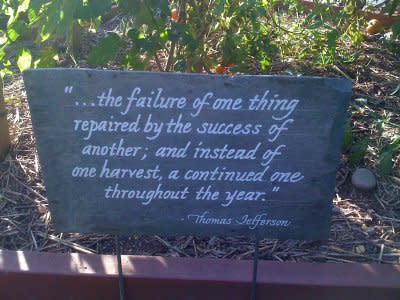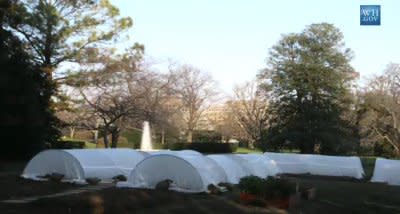The White House and the winter garden: Eating local all year long

When it comes to gardening, many people tend to assume that the growing season ends around the time the first frost appears. But that's not necessarily the case-at least, not at the White House.
"In a week, we're going to pull all this stuff and plant a winter garden," says White House chef Sam Kass, gesturing toward the spent squash vines, woody basil stalks, dried corn stalks among the garden beds in the South Lawn. "So we'll have hoop houses, so we'll grow all year long."
After sitting in on a roundtable discussion about issues that matter most to moms, Kass-who is also a senior policy adviser for healthy food initiatives and is very much involved in Michelle Obama's "Let's Move" campaign to eliminate childhood obesity-introduced Yahoo! Shine to one of his favorite projects: the White House garden.
"It's been an amazing experience," he says. "It's the first time that there's been a garden here that's really grown a lot of food since the late 1890s."
"We have peppers over here, these are really delicious peppers," Kass says, walking along the garden path. The tomatoes are basically done, but slim eggplants hang from plants in one neat bed, and another holds tall, trellised vines on which cling a few fat, fuchsia pods-scarlet runner beans. He reaches behind them to pluck some heirloom purple lima beans that are drying on the vine. "I just harvested some of these today, which I have in my pocket, when I was down here a little earlier," he says.

A quaint slate marker identifies this particular bed as one planted with seeds developed by Thomas Jefferson. Next to it is another bed that Kass says is the "Three Sisters Garden," a traditional planting system used by Native Americans that is still used in some parts of South America and Spain. "You have the corn that grows up-beautiful blue corn, which we harvested," he says, pointing to the stalks. "Then you see the beans run up, you can see some of the beans hanging off... And then the squash grows at the bottom."
The garden produces hundreds of pounds of food each season. Some ends up on the First Family's dinner table. "I cook out of here every night, so I'm going to take you back up, and I'm going to change into my chef coat and harvest some eggplant and some green beans, and get ready for dinner," Kass laughs. He gestures to the bok choy. "I'll probably cook some of that today."
The produce also gets used by the main White House kitchen. "We used a ton of it at the state dinner," Kass says. "We try to incorporate it whenever we can, at lunches that the President has, and that sort of thing. We also give about a third of it to a local soup kitchen, Miriam's Kitchen, that cooks fresh food for people in need." The garden is overflowing with herbs like sage, lemon grass, ginger, and several types of basil. "It's been good year for basil," Kass says. "We use a lot. We give a lot away. … it's hard to produce enough tomatoes for 200 people. But you can produce enough basil for 200 people."

With the fall harvest is almost over, it's time to think about setting the garden up for winter. But that doesn't mean it'll be lying fallow until spring. In the White House winter garden, "We do lots of spinach, kale, lots of lettuces, turnips, that kind of stuff," Kass explains.
Will kids really eat those hearty winter produce, though?
"Oh, they eat kale," he says. His secret to getting Malia and Sasha to eat the green stuff? "Just a touch of honey, maybe a little balsamic. Some caramelized onions for a little sweetness-it goes a long way."
He also says that Malia and Sasha like kale chips. "Roast them, make 'em crispy," he suggests. "They're great."
Interested in growing your own winter garden? Jennifer Lance at Sustainablog suggests starting to plan it out in late summer, and to pick seeds that are cultivated in a zone similar to that in which you'll be gardening. You can start your garden in containers indoors, or sow certain types of seeds directly into the ground in the fall. "I have started cabbage, cauliflower, Brussels sprouts and broccoli in containers, and I have directly sown broccoli as well," she writes. "Putting seeds in soil and watching sprouts emerge is actually my favorite part of growing food. No matter the size of your garden, you can put in a few winter garden plants and enjoy fresh food year round."
Also on Shine:
